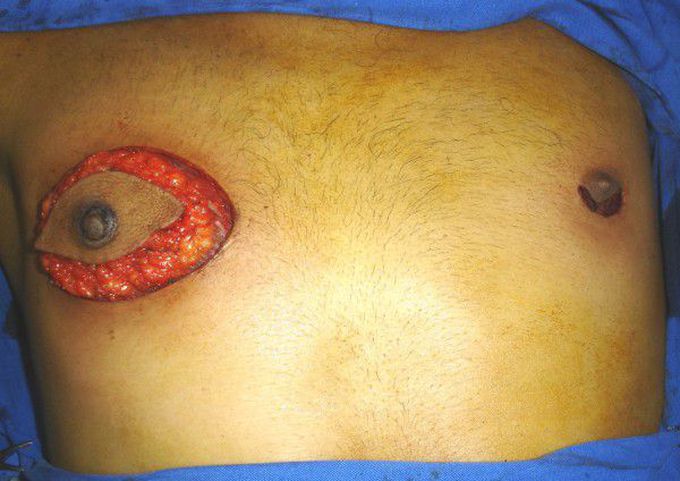


Surgery. Modified radical mastectomy (right breast) and retroareolar lumpectomy (left breast).
of infiltration into the dermis, which was reported in the present case. Treatment strategies for male breast cancer are not basedondatafromrandomizedclinicalstudiesinmen and most treatment recommendations are extrapolated from data in women [8]. Men with breast carcinoma have a poor prognosis, especially in the younger age group, because most breast enlargements in young men are dismissed as gyneco- mastia [9,10]. This potential misdiagnosis can result in an unnecessary delay in treatment. The median age of breast cancer diagnosis in men is approximately 65 years old [11]. Reports of breast cancer in young male patients are rare. Nielsen and Jakobsen described a breast cancer case in a 32-year-old man [12]. More recently, an invasive cancer case was reported in a 30-year-old patient [9]. In 2008, Chang et al. described the case of a 16-year-old male with unilateral ductal carcinoma in situ and gynecomastia [13]. There is a close relation between the BRCA2 gene mutation and male breast cancer. It has also been observed, however, that some cases involve BRCA1 participation [14-16]. Other conditions that have been associated with the occurrence of breast neoplasms in men are cirrhosis [17], testicular trauma, obesity, radia- tion therapy exposure, and the use of exogenous estro- gen [18]. In addition to the very young age of the patient in the present report, this patient did not have a family, hormonal, or genetic history that could justify the high risk for breast cancer. Although gynecomastia has been suggested to be present in 6-38% of breast cancer cases in men [19], it was not evident in our patient. It is fundamental to consider the history of breast tumors in first-degree relatives because that can be an indicator for increased breast cancer risk. Indeed, genetic diseases such as Klinefelter’ssyndromeand Cowden’s disease have been shown to be related to breast cancer in men [1]. There is no evidence that suggests that all men need breast magnetic nuclear resonance imaging (MRI). But suspicious MRI lesions in the contralateral breast should be examined. Furthermore, male breast cancer survivors have an increased risk of developing a second primary

